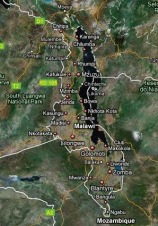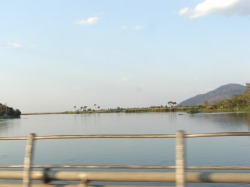Malawi- Commercial Agriculture in Thyolo
Location and Overview

Malawi
Malawi is a landlocked country of 11.85 million hectares [1] in Central Africa. It is bordered by Zambia to the North West, Tanzania to the North East and Mozambique to the South. Commercial agriculture is a major industry in Malawi, contributing considerably to Malawi’s exports and, in turn, its foreign exchange earnings.
Commercial agriculture in Thyolo and Mulange has been chosen as a case study. Most commercial agriculture estates in this area have several crops grown on a large scale and focus on one of these crops as their strength. The land dedicated to producing these crops can reach several thousand hectares per estate and is predominantly farmed extensively rather than intensively. Therefore, the majority of the estates employ high numbers of labour, which in many cases live on the estate and settle there with their families. In addition, many estates in Malawi as a whole are in fairly rural areas, some distance from the larger town and cities. Therefore, self sufficiency is a consideration that almost all long-standing estates hold important to ensuring constant production. This means that many estates also have fully functional garages, carpentry departments and engineering departments alongside factories to process the crops. These factors mean that the commercial agriculture estates can demand high levels of reliable energy to run effectively whilst also producing large amounts of agricultural, municipal and human waste.
Commercial agriculture in Thyolo and Mulange has been chosen as a case study. Most commercial agriculture estates in this area have several crops grown on a large scale and focus on one of these crops as their strength. The land dedicated to producing these crops can reach several thousand hectares per estate and is predominantly farmed extensively rather than intensively. Therefore, the majority of the estates employ high numbers of labour, which in many cases live on the estate and settle there with their families. In addition, many estates in Malawi as a whole are in fairly rural areas, some distance from the larger town and cities. Therefore, self sufficiency is a consideration that almost all long-standing estates hold important to ensuring constant production. This means that many estates also have fully functional garages, carpentry departments and engineering departments alongside factories to process the crops. These factors mean that the commercial agriculture estates can demand high levels of reliable energy to run effectively whilst also producing large amounts of agricultural, municipal and human waste.
Energy Issues

Liwonde Barrage on Shire River
The Electricity Supply Corporation of Malawi (ESCOM) “remains the only company that generates, transmits and distributes electricity on commercial terms in the country. Most of the power is generated from a number of power stations along the Shire river”[2]. The Shire River is Malawi’s largest river and runs from the outlet of Lake Malawi to where it joins the Zambezi River in Mozambique to the South. “Nearly 95% of Malawi’s electricity supply is provided by hydropower from a cascaded group of interconnected hydroelectric power plants located on the middle part of Shire River and a mini hydro on the Wovwe River. Total installed capacity of these hydropower plants is 282.5MW”[3]. The remaining 5% is harnessed from stand-by thermal power plants bringing the “total present installed capacity for the ESCOM system, inclusive of standby thermal plants, [to] about 299.65 MW”[3].
Malawi should be commended for such a high percentage of total energy being harnessed from a renewable resource. Unfortunately however, Malawi has a reputation for unreliable electricity supplies. This can be largely attributed to problems with the hydropower plants on the Shire River. According to ESCOM, “the hydropower plants on the Shire River....have operated without major problems until in recent years when floating aquatic weeds/plants and debris being transported in the river have caused severe operational problems and damage to intake structures. Siltation of power plants reservoirs has also contributed immensely to the operational problems”[3]. With such a high proportion of Malawi’s total electricity coming from hydropower, any problems with the plants and/or river mean, often severe, electricity supply problems where load-shedding is required. This hinders the agriculture industry as the estates require constant high levels of electricity to operate continuosly. The problems can also be more frequent and serious during the wet season from “October to April”[4] when river flows, and consequently river load, increase. In addition, this is a busy period of the year for the agriculture industry and soonly adds to the problems. Consequently, most estates purchase very large, expensive diesel generators as a back-up against this problem.
Malawi should be commended for such a high percentage of total energy being harnessed from a renewable resource. Unfortunately however, Malawi has a reputation for unreliable electricity supplies. This can be largely attributed to problems with the hydropower plants on the Shire River. According to ESCOM, “the hydropower plants on the Shire River....have operated without major problems until in recent years when floating aquatic weeds/plants and debris being transported in the river have caused severe operational problems and damage to intake structures. Siltation of power plants reservoirs has also contributed immensely to the operational problems”[3]. With such a high proportion of Malawi’s total electricity coming from hydropower, any problems with the plants and/or river mean, often severe, electricity supply problems where load-shedding is required. This hinders the agriculture industry as the estates require constant high levels of electricity to operate continuosly. The problems can also be more frequent and serious during the wet season from “October to April”[4] when river flows, and consequently river load, increase. In addition, this is a busy period of the year for the agriculture industry and soonly adds to the problems. Consequently, most estates purchase very large, expensive diesel generators as a back-up against this problem.
Waste Issues

Agricultural Waste
A third factor is the problem of waste disposal in these rural areas where municipal and human waste disposal systems can be almost non-existent. Currently, most waste products are either burned, buried, sold very cheaply or composted if possible. The only current disposal method achieving any benefit to the estates is composting. It could therefore be suggested that a method of recovering energy from waste products would be a sensible and welcome help. If some energy could be recovered from agricultural, municipal and miscellaneous waste, several benefits could be derived. These could be in the form of cost savings, a solution to waste disposal, increased self-sufficiency, improved electricity reliability and potential improvements in the standard of living of labourers if some of this energy was redirected for their benefit. There may also be other benefits in the form of by-products from the energy recovery processes.
References
[1] National Statistical Office of Malawi, Malawi in Figures, http://www.nso.malawi.net/ Accessed on 29.10.2009
[2] Electricity Supply Corporation of Malawi (ESCOM) Limited, About ESCOM, http://www.escommw.com/about-us.php Accessed on 29.10.2009
[3] Electricity Supply Corporation of Malawi (ESCOM) Limited, About ESCOM, Generation, http://www.escommw.com/generation.php Accessed on 30.10.2009
[4] National Statistical Office of Malawi, Malawi in Figures, http://www.nso.malawi.net/ Accessed on 30.10.2009
Map of Malawi courtesy of Google Maps UK http://maps.google.co.uk/maps?hl=en&source=hp&q=malawi&um=1&ie=UTF-8&sa=N&tab=wl Accessed on 02.11.2009
Picture of Liwonde Barrage taken by Thomas Mullan
Picture of Agricultural waste courtesy of http://www.docklandsrecycling.co.uk/waste-recycling-services/types-of-waste-collected/garden-and-green-waste.html Accessed on 02.11.2009
[2] Electricity Supply Corporation of Malawi (ESCOM) Limited, About ESCOM, http://www.escommw.com/about-us.php Accessed on 29.10.2009
[3] Electricity Supply Corporation of Malawi (ESCOM) Limited, About ESCOM, Generation, http://www.escommw.com/generation.php Accessed on 30.10.2009
[4] National Statistical Office of Malawi, Malawi in Figures, http://www.nso.malawi.net/ Accessed on 30.10.2009
Map of Malawi courtesy of Google Maps UK http://maps.google.co.uk/maps?hl=en&source=hp&q=malawi&um=1&ie=UTF-8&sa=N&tab=wl Accessed on 02.11.2009
Picture of Liwonde Barrage taken by Thomas Mullan
Picture of Agricultural waste courtesy of http://www.docklandsrecycling.co.uk/waste-recycling-services/types-of-waste-collected/garden-and-green-waste.html Accessed on 02.11.2009
